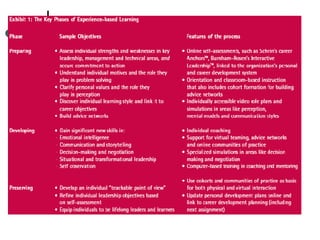Leadership Development
- 1. Leadership Development Gautam Ghosh 18 June 2007
- 2. Experience Based LD In an Accenture study of leaders under the age of 35 and over the age of 70, entrepreneurs, corporate executives, social activists and elected politicians unanimously agreed that they had learned more about leading from real work and life experiences than from leadership development courses or MBA programs. They credited the latter with helping them become more competent technically, but they argued that formal programs do little to help people learn fundamental lessons or how to extract wisdom from experience. The experience-based approach represents a comprehensive new way of developing leaders. It knits together on-the-job experience, life experience and specific skill development, rather than presenting employees with a smorgasbord of classes and programs that is tenuously linked (if it is linked at all) to career development, succession planning or business objectives. The experienced-based method can be adapted to the developmental needs and opportunities of people at all stages of their careers, and also to the changing needs of organizations operating in complex and uncertain environments. http://www.accenture.com/NR/rdonlyres/C588B39B-DF97-43E7-946A-AE467CF3BF9F/0/researchnote_230.pdf
- 4. Leadership Development Based on the Leadership Pipeline: there are skill, time, and value development needs at each “leadership turn.” Source: The Leadership Pipeline , by Ram Charan, Stephen Drotter, and James Noel
- 5. Developing “Whole” Leaders Companies most often use: Training for Cognitive Skills Self-directed learning Custom-designed programs Open-enrollment programs Coaching for Emotional Skills 360 º feedback Executive coaching Formal mentoring Experiences for Values and Decisiveness Action learning Job rotation Business scenario simulation
- 6. Approaching the Leadership Pipeline Strategically Action Learning Strategic Leadership programs Action Coaching Few Many Equip for Today Prepare the Future Build and Maintain Leadership Pipeline Develop the Targeted Few Transform the Business Educate and Train the Many Critical skills Pool assessment Accelerated development On-boarding Special assignments Executive coaching Change-agent development Leaders teaching leaders Business-issue focus Build the culture Execute strategy Advance key initiatives
- 7. Some Thoughts in Closing . . . Complex times call for complete leaders : head, heart and guts Companies that approach leadership development strategically will have an advantage over those that select and implement programs and techniques ad hoc. A leadership development program will not succeed unless it is a business imperative that is led and supported by the CEO and his or her executive team.







